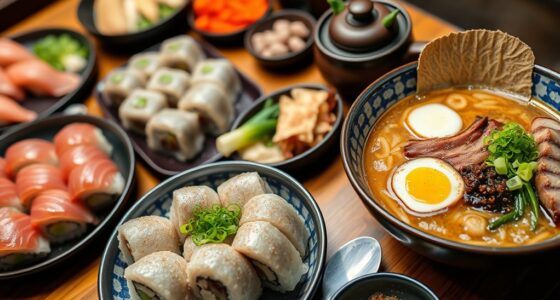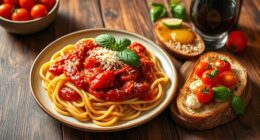Chinese regional cuisines showcase a vibrant mix of flavors influenced by geography, culture, and climate. In the north, hearty wheat-based foods like noodles and Peking duck dominate, while the south emphasizes delicate seafood dishes and subtle seasonings. Southwest flavors are bold and spicy, with Sichuan and Yunnan specialties, whereas Xinjiang and Tibet offer hearty, high-altitude foods. Exploring these diverse traditions reveals a tapestry of unique tastes and stories that shape China’s culinary landscape—stay tuned to uncover more fascinating details.
Key Takeaways
- China’s vast geography and diverse climates cultivate unique regional ingredients and flavors.
- Northern cuisine features hearty, wheat-based foods like noodles and Peking duck.
- Jiangnan and Southern regions emphasize delicate, seasonal ingredients with subtle seasoning.
- Sichuan and Yunnan cuisines are known for bold, spicy, and earthy flavors using fresh herbs and preserved foods.
- Western and Highland areas like Xinjiang and Tibet offer hearty, spice-rubbed meats and warming dishes suited for cold climates.

Chinese cuisine is incredibly diverse, reflecting the country’s vast geography, rich history, and regional cultures. As you explore China’s culinary landscape, you’ll quickly notice how each region offers distinctive flavors, ingredients, and cooking techniques that tell their own stories. This diversity isn’t accidental; it results from centuries of cultural exchange, local resources, climate variations, and historical influences shaping regional identities.
Chinese cuisine’s rich diversity reflects its vast geography, history, and regional cultures, creating a tapestry of unique flavors and traditions.
From the spicy, bold flavors of Sichuan to the subtle, refined tastes of Jiangnan, each cuisine invites you to discover new tastes and culinary traditions.
In the north, you’ll find hearty, wheat-based foods like noodles, buns, and pancakes that suit the colder climate. Beijing’s Peking duck, with its crispy skin and tender meat, exemplifies the region’s culinary style—rich, savory, and meticulously prepared.
Moving south, the flavors become lighter and more delicate. Jiangnan cuisine, encompassing Shanghai and nearby areas, emphasizes fresh, seasonal ingredients with a focus on seafood, soups, and subtly seasoned dishes. The region’s cuisine is known for its sweetness and umami, often achieved through slow braising and steaming techniques that preserve the natural flavors of ingredients. Additionally, the use of cooking techniques such as gentle steaming and slow braising helps maintain the integrity of delicate flavors.
Venture into the southwestern provinces like Sichuan and Yunnan, and you’ll encounter a bold explosion of flavors. Sichuan cuisine is famous for its liberal use of chili peppers, garlic, and Sichuan peppercorns, which create a signature numbing-spicy sensation. Dishes like Mapo tofu and kung pao chicken are perfect examples of this fiery, complex flavor profile.
Yunnan cuisine, on the other hand, highlights fresh herbs, mushrooms, and preserved vegetables, reflecting its lush, mountainous landscape. The use of wild ingredients and unique fermentation methods produces flavors that are both earthy and vibrant, inviting you to experience the region’s natural bounty.
Further west, you find the flavors of Xinjiang and Tibet, which are heavily influenced by Central Asian and Himalayan traditions. Xinjiang cuisine features hearty, spice-rubbed meats like lamb, often cooked in kebabs or braised stews, complemented by flatbreads and dried fruits.
Tibetan dishes focus on warming, filling foods like momos (dumplings) and butter tea, designed to sustain you in a high-altitude environment. These regional cuisines reflect their historical crossroads, blending influences from different cultures while maintaining unique local characteristics.
In essence, the diversity of Chinese regional cuisines offers a culinary map that spans from the fiery plains of Sichuan to the serene lakes of Jiangnan. Each region’s dishes are an expression of its environment, history, and people, giving you an incredible variety of flavors to explore.
As you taste your way through China’s culinary tapestry, you’ll discover that each dish is more than just food—it’s a piece of the region’s identity, waiting for you to uncover.
Frequently Asked Questions
How Do Regional Climates Influence Chinese Cuisine Ingredients?
You might wonder how climates shape Chinese cuisine ingredients. In hot, humid areas, you’ll find more cooling foods like watermelon and mung beans to beat the heat.
Cold regions favor hearty, preserved foods such as pickled vegetables and dried meats to get through harsh winters.
Rainy climates lead to rice and freshwater fish becoming staples, while dry areas rely on grains like wheat and millet.
Your dishes reflect these climate-driven ingredient choices.
What Are the Key Cooking Techniques Unique to Each Region?
Imagine each region’s cooking techniques as a unique brushstroke on China’s culinary masterpiece. In the North, you’ll find bold stir-frying that dances over high heat.
In Sichuan, you master the art of numbing and spicy simmering. Cantonese chefs gently steam delicate seafood, while Jiangsu cooks with slow braising, tender like a well-loved song.
These techniques shape each area’s flavors, making Chinese cuisine a vibrant tapestry of culinary artistry.
How Has Chinese Cuisine Evolved Over Centuries Across Regions?
You see, Chinese cuisine has evolved over centuries by blending regional flavors, ingredients, and techniques. As people traveled and traded, they shared recipes and cooking styles, leading to innovations and adaptations.
Dynasties influenced food preferences, while local climates shaped ingredient availability. You can observe this evolution in dishes that have transformed or combined influences, creating a rich, diverse culinary history that continues to develop today through modern twists and global exchanges.
What Role Do Local Festivals Play in Regional Culinary Traditions?
You see, local festivals play a crucial role in preserving and celebrating regional culinary traditions. During these events, you get to taste special dishes that honor history, harvests, or cultural myths.
Festivals encourage community participation, passing recipes and cooking techniques from generation to generation. They also attract visitors, spreading regional flavors wider.
How Do Regional Cuisines Influence Modern Chinese Food Trends?
Did you know that over 80% of Chinese people prefer authentic regional dishes? Regional cuisines heavily influence modern Chinese food trends by inspiring innovative fusion dishes that blend traditional flavors with contemporary techniques.
You’re likely to see more local ingredients and cooking styles in urban restaurants, reflecting regional culinary identities. This trend helps preserve cultural heritage while appealing to modern tastes, making Chinese cuisine both diverse and dynamic today.
Conclusion
Just as a vast tapestry weaves countless vibrant threads into a masterpiece, Chinese regional cuisines showcase an incredible diversity that reflects its rich history and culture. Each dish is like a brushstroke on this culinary canvas, inviting you to explore flavors as varied as mountains, rivers, and bustling markets. Embrace this culinary journey, and you’ll see that China’s food landscape is a living map of its soul—ever-changing, deeply rooted, and beautifully unique.









